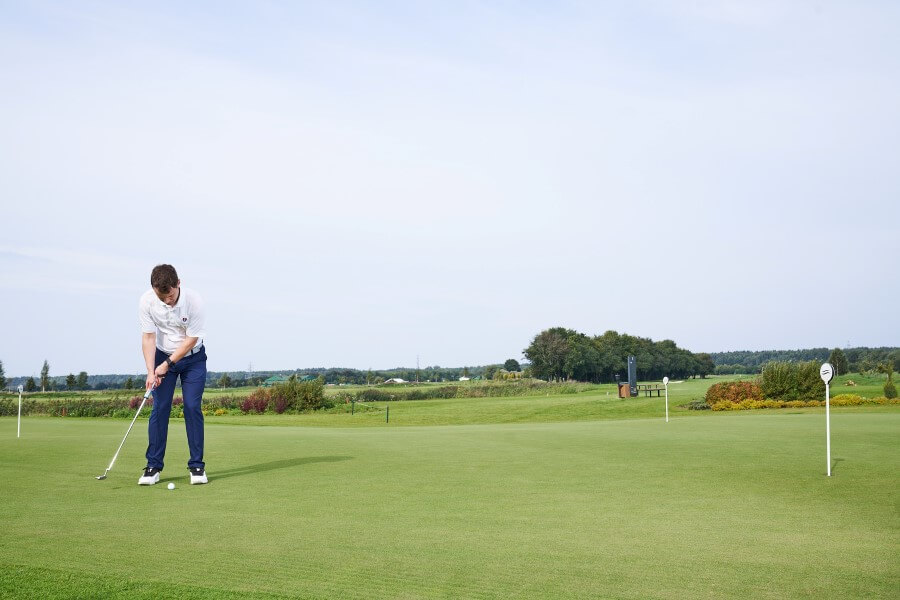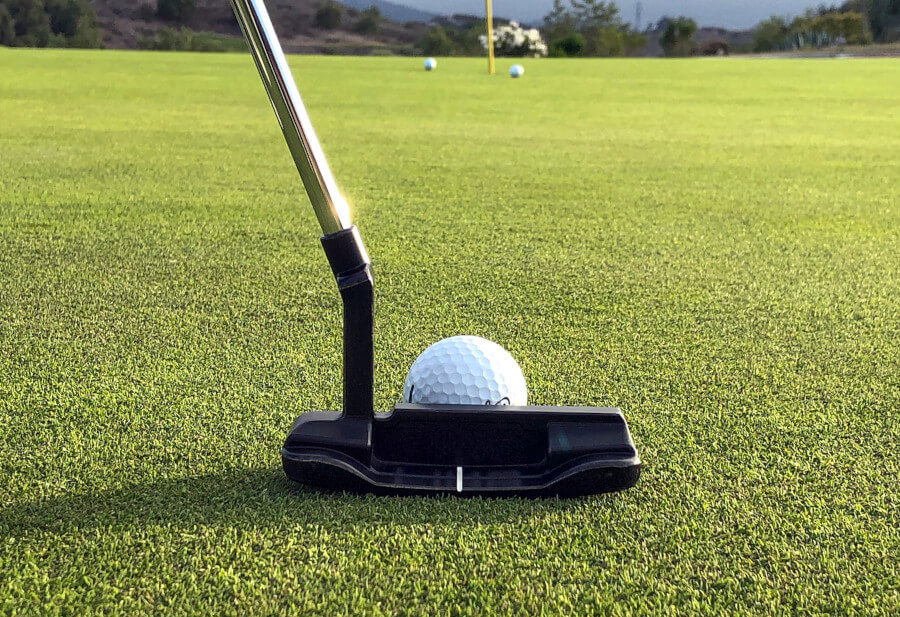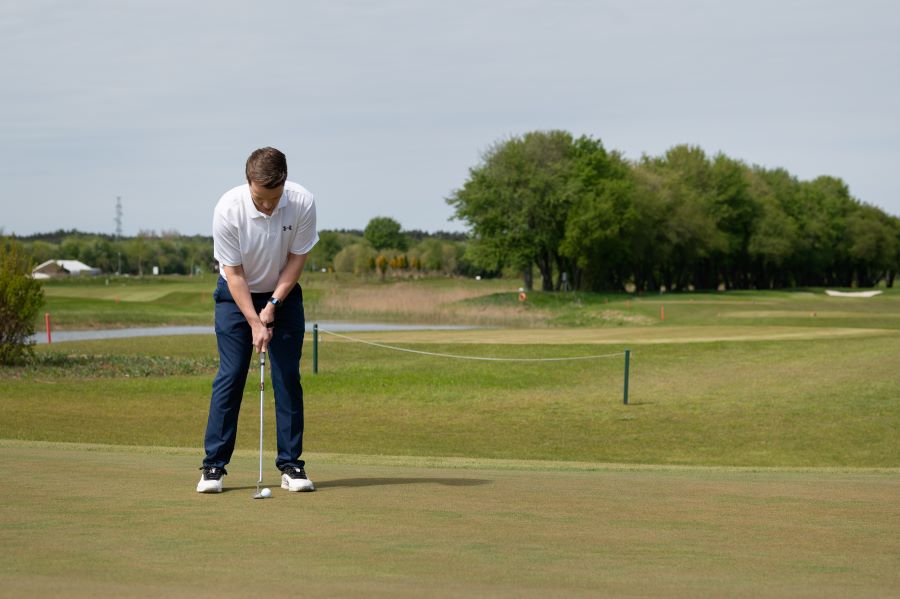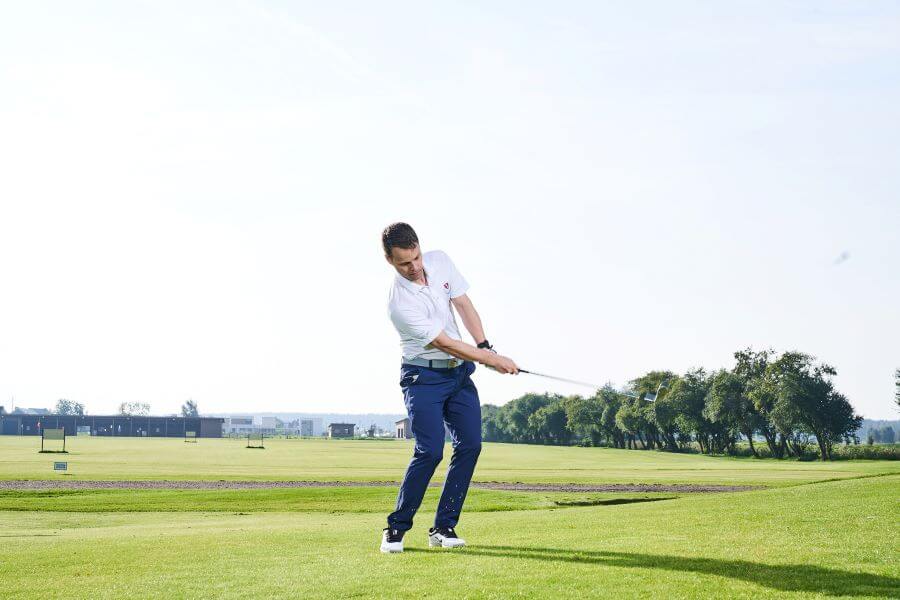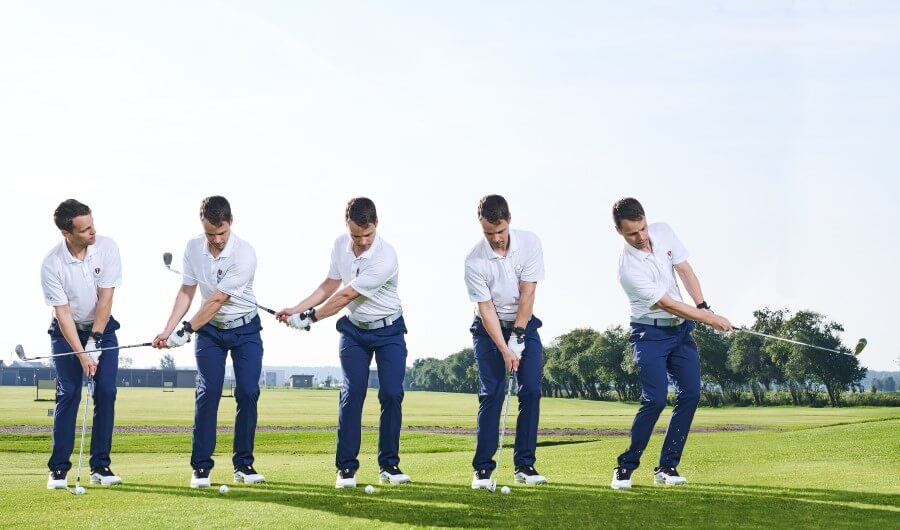The Bunker Shot Blueprint: 10 Pro Tips for More Up and Downs
We have all had our sand trap nightmares. Taking two or more swings to get the ball out of a bunker is just frustrating and a waste of strokes.
We are going to look at the top 10 tips for bunker shots to make sure you can consistently get up and down from the bunker.
Instead of just getting the ball out, let’s set the goal to actually get it close and tap the putt in.
How to Hit Out of a Bunker (Key Takeaways)
If you don’t have time to read our entire guide on getting more up and downs from the bunker, here are a few key concepts you could take with you right now.
- Select a lofted club to launch the ball high and out of the bunker, sometimes a 56 degree sand wedge isn’t enough and a 60 degree wedge is better.
- Play a high bounce sole grind to increase glide through the sand.
- Open your clubface slightly for added loft.
- Position the golf ball forward in your stance to promote striking the sand first.
- Lengthen your backswing to prevent clubhead speed loss through the sand.
- Extend the lead wrist to add more loft to your clubface.
- Hit the sand before your ball to get the clubface to travel under it and launch it out of the bunker.
Contents
10 Actionable Tips to Hit Better Bunker Shots
1. Select a Lofted Club
When trapped in a greenside bunker, especially one with a lip, you need loft.
I suggest using a minimum of a 54-degree sand wedge. However, if you have more loft, like a 56 or 58-degree wedge, those are great to use as well. Remember that the higher the loft of the club, the shorter the total distance the ball will travel.
If you have a long way to go to the pin, stick with the 52 or 54, if you have no room to work with, a 60 degree could be perfect.

2. Play a High Bounce Sole Grind
Besides club selection, take a look at your wedge’s sole grind.
The average amateur is better equipped with a high bounce and forgiving sole grind that halts your clubhead from digging into the sand and losing speed leading into contact.
I find that mid and high-handicappers are best equipped with a design like the K-grind sole, which optimizes bounce and forgiveness in the sand.
As great as it is to have a high bounce wedge for bunker shots, it’s not the easiest club to hit from the fairways. Most golfers end up with a mid bounce option that works for both.
3. Open the Clubface
Besides playing a lofted club, it is up to you to adjust the dynamic loft of the wedge by further manipulating the clubface open at address.
I find it easier to prop the clubface open with my right hand before gripping it. Sometimes, this makes it easier to get the club in the right position without feeling awkward in the hand and wrist position.
Open the clubface in small increments so you aren’t left with something too difficult to control.
Luke Donald employs the Dumping Sand drill to master the clubface position in the bunker.
Add sand to your clubface at address and take a few swings, stopping at the top of the backswing.
If the dirt falls off before the top, your clubface is too closed, and you’ll struggle to produce sufficient loft at impact.
4. Position the Ball Forward
Contrary to other short-game shots, you want the ball forward in your stance for a bunker strike.
Chris Ryan recommends placing your wedge a blade length from your front foot to give you time to open the clubface, catch sand and launch the ball out of the trap.
With the ball positioned forward, you can open the clubface at address with the shaft almost leaning backward.
This exposes the wedge’s bounce and pushes the trailing edge lower than the leading edge.
When you place the ball too far back in your stance, you may end up taking no sand with you, decreasing the loft and leaving the ball in the bunker.
5. Place Weight on Your Front Foot
Positioning additional weight on your lead leg combines with a front ball position to power your clubface through the sand and into impact.
Often mid and high handicappers set up with extra weight on their trail leg, thinking it will help them lift the ball out of the sand and into the air.
However, nothing good ever comes from leaning back on any golf shot. Your clubface will enter the sand too early, bounce up, and catch the ball in the teeth.
Many professionals suggest placing as much as 75% of your weight on the front foot, which is not the worst advice to eradicate the habit of leaning back.
6. Dig Your Feet Into the Sand
Address your golf ball and gently corkscrew your feet into the sand until you are firmly rooted to the ground.
This little bit of extra stability can help prevent any slipping or sliding when you take your bunker shot.
Rotate your hips back and forth two to three times to double-check your traction, and if your feet remain stable, you are ready to take the club back.
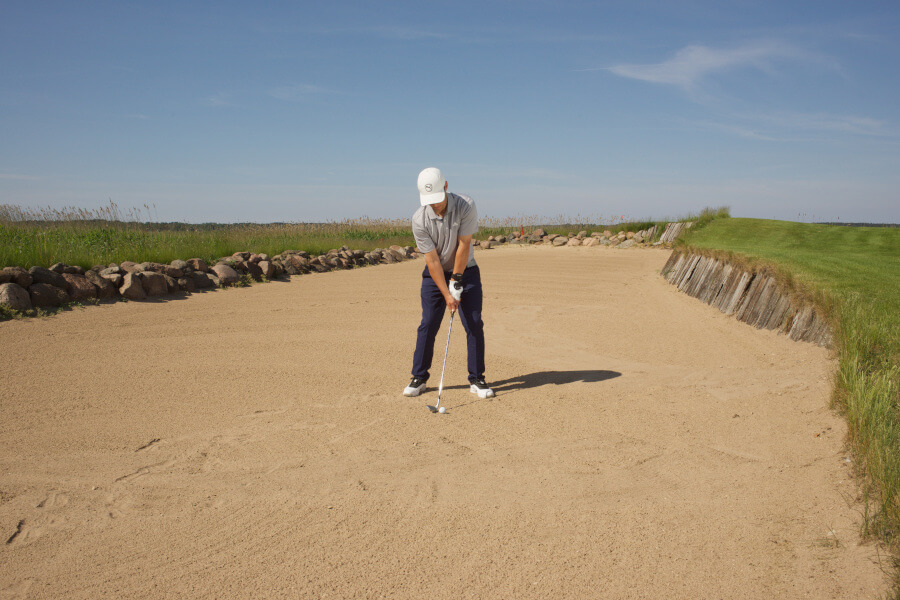
7. Aim At the Target
Most amateur players tend to aim to the left of the target, compensating for the open clubface. However, sometimes, this aim throws the club path off.
Players swing kind of out to in and it decreases the strength of the golf shot and leaves the ball to come up a little short. Instead, aim directly at your target, the open clubface will increase loft but it shouldn’t change your alignment.
You will optimize your entry point into the sand, produce a clean strike, and control your power and distance with maximum precision.
8. Lengthen Your Backswing
Sticking with the theme of distance control, I often see golfers misjudging the power of their strike because of the proximity of the flagstick.
If the pin is 15 yards away, the average golfer feels they need to induce a shorter backswing, akin to the requirements for a chip shot.
Chip shots are often struck with a lower lofted face than out of the bunker, as you don’t have to navigate sand.
However, when your club enters the sand, it slows down clubhead speed, leaving you to account for it on your backswing.
9. Extend the Lead Wrist
Up until this point, my tips on how to hit out of the bunker traps have revolved around easy tweaks you can employ in your swing.
Now we get to the nitty gritty diving into lead wrist extension, which is imperative for prompting an open clubface into impact.
Fredrik Lindblom from Short Game Gains explains that an extended lead wrist at the top of the swing helps induce wrist hinge.
In other words, the logo on your glove is pointing toward the sky at the top of your backswing. With this position, you’ll have an easier time keeping the clubface open at impact and getting enough loft on your shot.
HackMotion offers the world’s best coaches, player’s and the average golfer an efficient solution to wrist angles.
The HackMotion swing analyzer trains you to produce the prerequisite lead wrist extension on every bunker shot to help you escape the sand and get up and down.
10. Hit the Sand Behind Your Ball
You’ve heard coaches harp on about following through after impact.
However, many amateurs still stab at the ball in the bunker, causing the club head to dig into the sand and experience a significant velocity drop-off.
Understand that the way the ball gets out of the bunker is to hit the sand behind the ball.
As long as you accelerate through the shot, you’ll get the ball out with plenty of height and a soft landing.
Why do I Struggle with Bunker Shots?
Amateurs struggle with bunker shots because they do not catch enough sand before the ball.
Or, they produce a short backswing and lose clubhead speed into impact.
In addition, amateurs place the ball too far back in the stance and fail to extend their lead wrist during the swing to deloft the clubface.
Final Thoughts
These tips for bunker shots are based on analyzing over 1,000,000 golf swings with the help of HackMotion. The basic bunker shot does not need to be as hard as most people think it is.
Every tip is designed to supplement the next piece of the puzzle, ensuring you escape the sand trap every time and improving your sand saves record.
However, the tip that changes your bunker play is extending your lead wrist.
It is incredible how a simple wrist tweak can optimally position the clubface for a clean, high-launching bunking shot. Learn more about the importance of wrist angles with HackMotion.





